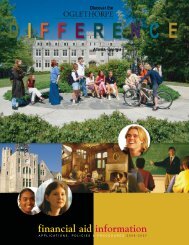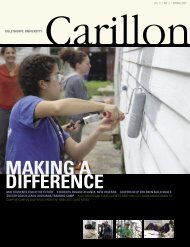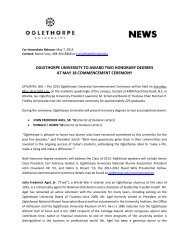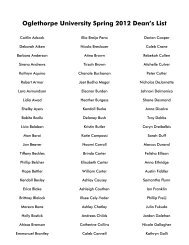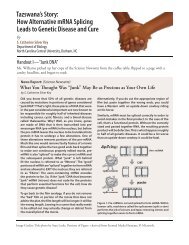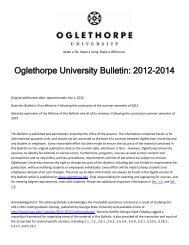Spring 2010 - Oglethorpe University
Spring 2010 - Oglethorpe University
Spring 2010 - Oglethorpe University
Create successful ePaper yourself
Turn your PDF publications into a flip-book with our unique Google optimized e-Paper software.
our History<br />
our History<br />
What’s in<br />
a Name?<br />
“The architecture of an institution of learning should<br />
be a constant source of delight and inspiration to its<br />
students, teaching quietly but surely the highest ideals<br />
of life. Not less important are the personal surroundings<br />
of the student’s room. Cheap, ugly and illequipped<br />
apartments have exactly the same<br />
influence on the soul of a boy that cheap, ugly<br />
and ill-equipped human companions have. In<br />
brief, the college education that does not teach a<br />
love of beauty and order and what is popularly<br />
called decency is essentially and dangerously<br />
defective.” – Thornwell Jacobs<br />
Gothic Gray Stone and Mortar:<br />
the Silent Faculty at <strong>Oglethorpe</strong><br />
In a memorandum of May 6, 1914, to his<br />
Executive Committee, Thornwell Jacobs<br />
set enduring architectural standards for<br />
<strong>Oglethorpe</strong> <strong>University</strong>. The campus was to<br />
serve as a “living memorial” to the founder<br />
of Georgia, James Edward <strong>Oglethorpe</strong>,<br />
an alumnus of Corpus Christi College<br />
of Oxford <strong>University</strong>. There could be no<br />
other choice for the design of <strong>Oglethorpe</strong><br />
<strong>University</strong>. “I refer to the pointed style<br />
of architecture known as Gothic,”<br />
Jacobs declared.<br />
Another inspiration for Jacobs was his<br />
alma mater, Princeton <strong>University</strong>, with its<br />
gothic arches, mullioned windows, tower<br />
forms and craggy walls with engraved<br />
shields. “You can put in the face of a<br />
building,” he wrote, “dignity, reverence,<br />
honesty and beauty.” A fitting material<br />
for gothic architecture is granite, and<br />
Jacobs managed to secure donations<br />
of high quality stone from Elberton,<br />
Georgia. Emphasizing solidity and a<br />
vision of the finest, Jacobs wanted steel<br />
frames, Vermont slate roofs, and Indiana<br />
limestone trim.<br />
Jacobs hired the distinguished Atlanta<br />
firm of Thomas Henry Morgan and John<br />
Robert Dillon to design <strong>Oglethorpe</strong>.<br />
Morgan, considered “dean of Atlanta<br />
architects,” executed many High Victorian<br />
landmarks in the city, including Agnes<br />
Scott Hall (1891) and North Avenue<br />
Presbyterian Church (1898). Morgan &<br />
Dillon associate architect Walter Thomas<br />
Downing designed Sacred Heart Church<br />
(1897) and the elegant Healey Building<br />
(1913). From 1915 to 1928 Morgan & Dillon<br />
with Downing designed three gothic<br />
granite halls on a landscaped quadrangle<br />
with an impressive driveway, all listed on<br />
the National Register of Historic Places.<br />
Administration Building (now Hearst<br />
Hall) opened its doors in 1916. The only<br />
<strong>Oglethorpe</strong> historic structure without a<br />
tower form, it established a pattern for<br />
the original campus structures. They<br />
are two and a half stories with gables in<br />
the roofs and lower level ground floors,<br />
serving as all-purpose buildings. There<br />
was a cafeteria where the bookstore is<br />
now. Classrooms and laboratories were<br />
on the first floor and faculty offices and<br />
dormitory rooms were on the upper floors.<br />
The Great Hall, designed by Downing,<br />
is substantially unchanged. In 1948 the<br />
building was renamed Phoebe Hearst<br />
Hall, after the co-founder of the PTA<br />
and the mother of publisher William<br />
Randolph Hearst.<br />
Lupton Hall is actually three separate but<br />
connected buildings, starting with a bell<br />
and clock tower (once freestanding, with<br />
Westminster chimes, giving the campus<br />
a musical dimension), a middle part, and<br />
the auditorium section with a fine portico.<br />
They commemorate the mother, wife and<br />
son of John Thomas Lupton, founder of<br />
the Coca-Cola bottling company. The key<br />
to navigating Lupton Hall, Jacobs’s “triple<br />
dream come true,” are its three sections,<br />
with separate staircases. Lowry Hall,<br />
expanded into Philip Weltner Library,<br />
bears a striking resemblance to the<br />
Gateway Tower at Corpus Christi College<br />
Oxford. Over the entrance is a fine old<br />
lantern from Corpus Christi.<br />
Jacobs called the <strong>Oglethorpe</strong> buildings the<br />
“Silent Faculty”, believing them to be “a<br />
constant source of delight and inspiration,<br />
teaching the highest ideals of life.”<br />
Certainly, <strong>Oglethorpe</strong>’s gray stone and<br />
mortar challenges the best of those who<br />
enter our hallowed halls.<br />
By Dr. Paul Stephen Hudson ’72<br />
Lupton Hall<br />
is named after John Thomas Lupton,<br />
the owner of the Southern Franchise of<br />
the Coca-Cola Bottling Company. During<br />
a fundraising campaign to re-found<br />
<strong>Oglethorpe</strong> <strong>University</strong>, Thornwell Jacobs<br />
met Lupton in Chattanooga. Lupton was<br />
impressed by Jacobs and his passion to<br />
start an institution of higher learning.<br />
Lupton Hall was completed in three<br />
parts, with groundbreaking ceremonies<br />
in 1922, 1924, and 1927. The first part<br />
of Lupton Hall, including the bell tower,<br />
was erected as a memorial to Lupton’s<br />
mother. The middle portion was dedicated<br />
to his son, Carter, and the third<br />
section, including the auditorium, honored<br />
his wife. Beginning with his pledge<br />
of $10,000 in 1914, Lupton gave a total<br />
of $1,018,000 to <strong>Oglethorpe</strong> before his<br />
death in 1933.<br />
Hearst Hall<br />
was the first building on campus and was<br />
named by publisher William Randolph<br />
Hearst in honor of his mother Phoebe Apperson<br />
Hearst. The publisher had given<br />
<strong>Oglethorpe</strong> a sizable donation of land,<br />
and in the early 1930s the <strong>Oglethorpe</strong><br />
campus covered approximately 600 acres.<br />
This included 30-acre Silver Lake, which<br />
was, for a time, renamed Lake Phoebe.<br />
The Philip Weltner Library<br />
was dedicated in 1992, named for past<br />
<strong>Oglethorpe</strong> President Philip Weltner<br />
(1944-1953), a noted attorney and educator.<br />
The current library was a result of<br />
an addition to the original Lowry Hall<br />
(named for Emma Markham Lowry) built<br />
in 1925. Weltner initiated an exciting<br />
approach to undergraduate education<br />
called the “<strong>Oglethorpe</strong> Idea”—one of the<br />
earliest efforts to develop a core curriculum,<br />
with the twin aims to “make a life<br />
and to make a living.”<br />
Emerson Student Center<br />
was built in 1968, but remained nameless<br />
until trustee Bill Emerson made a $250,000<br />
gift to the school in 1982. The building<br />
was named to honor Bill, now an emeritus<br />
trustee, and his wife Jane in 1983.<br />
Goodman Hall<br />
was built in 1956 as a men’s dorm and<br />
was named in memory of Charles “Puggy”<br />
Goodman, a Milton Bradley executive<br />
and a university trustee and benefactor<br />
from 1945 until his death in 1955.<br />
Goslin Hall<br />
opened in 1971 and was named for Dr.<br />
Roy Goslin, professor of physics who<br />
joined the <strong>Oglethorpe</strong> faculty in 1946.<br />
Goslin had previously worked on the<br />
famous Manhattan Project in 1944.<br />
robinson Hall<br />
then called Faith Hall, was built in the<br />
1940s. Beginning with only $3000 and the<br />
faith of President Thornwell Jacobs, ground<br />
was broken by Mrs. Hugh N. Bancker,<br />
president of <strong>Oglethorpe</strong>’s Women’s Board.<br />
In May 1942, Bancker placed a copper<br />
box in the cornerstone following the 23 rd<br />
commencement, yet $35,000 was still<br />
needed to complete the building. In 2000,<br />
J. Mack Robinson, an Atlanta entrepreneur,<br />
businessman, philanthropist (and breeder<br />
of thoroughbred racehorses!), gave funds to<br />
finish what is now named Robinson Hall in<br />
his honor.<br />
Fun Fact<br />
From 1965 through part of 1972 the<br />
institution was called <strong>Oglethorpe</strong><br />
College. But the historical identity of<br />
<strong>Oglethorpe</strong> <strong>University</strong> was so strong<br />
that in 1972 the original chartered<br />
name was re-established.<br />
8 CARILLON | SPRING <strong>2010</strong><br />
SPRING <strong>2010</strong> | CARILLON 9







